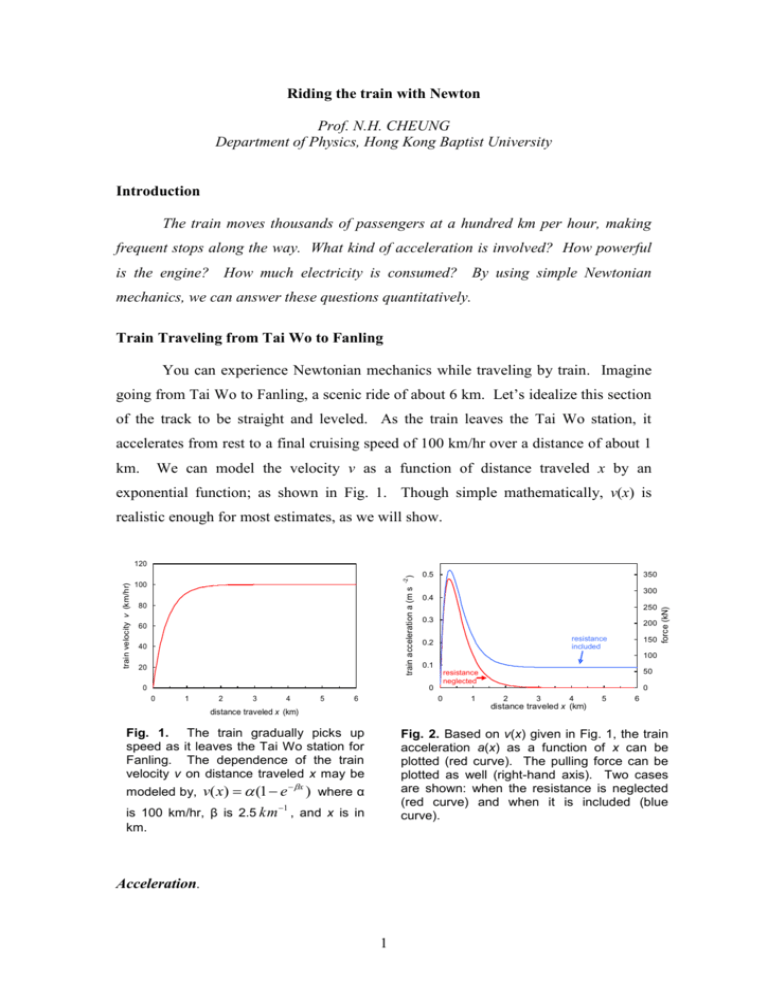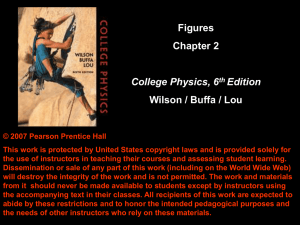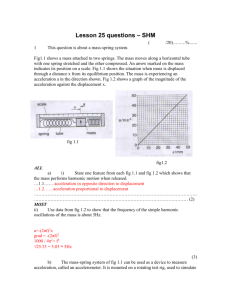Riding the train with Newton
advertisement

Riding the train with Newton Prof. N.H. CHEUNG Department of Physics, Hong Kong Baptist University Introduction The train moves thousands of passengers at a hundred km per hour, making frequent stops along the way. What kind of acceleration is involved? How powerful is the engine? How much electricity is consumed? By using simple Newtonian mechanics, we can answer these questions quantitatively. Train Traveling from Tai Wo to Fanling You can experience Newtonian mechanics while traveling by train. Imagine going from Tai Wo to Fanling, a scenic ride of about 6 km. Let’s idealize this section of the track to be straight and leveled. As the train leaves the Tai Wo station, it accelerates from rest to a final cruising speed of 100 km/hr over a distance of about 1 km. We can model the velocity v as a function of distance traveled x by an exponential function; as shown in Fig. 1. Though simple mathematically, v(x) is realistic enough for most estimates, as we will show. 80 60 40 20 0.5 350 300 0.4 250 0.3 200 resistance included 0.2 100 0.1 0 1 2 3 4 5 0 6 50 resistance neglected 0 0 150 force (kN) -2 100 train acceleration a (m s train velocity v (km/hr) ) 120 1 0 2 3 4 5 6 distance traveled x (km) distance traveled x (km) Fig. 1. The train gradually picks up speed as it leaves the Tai Wo station for Fanling. The dependence of the train velocity v on distance traveled x may be Fig. 2. Based on v(x) given in Fig. 1, the train acceleration a(x) as a function of x can be plotted (red curve). The pulling force can be plotted as well (right-hand axis). Two cases are shown: when the resistance is neglected (red curve) and when it is included (blue curve). v( x) (1 e x ) where α 1 is 100 km/hr, β is 2.5 km , and x is in modeled by, km. Acceleration. 1 We will first calculate the acceleration a(x) as a function of x. Using elementary calculus, we have, a dv dv dx dv v; dt dx dt dx (1) so a(x) is simply the slope of the curve of v(x) vs x (Fig. 1) times the velocity. This is plotted in Fig. 2 (red curve, left-hand axis). As can be seen, the train accelerates maximally near the beginning, and soon travels at a constant velocity. The peak acceleration is about 5% of the acceleration due to gravity, which is well within the comfort zone of most people. Start up power We now estimate the force exerted by the engine to accelerate the train. There are typically 12 carriages per train, each weighing about 40 metric ton when empty. Loading capacity is about 300 passengers each. So the total mass is about 7 10 5 kg. The start up force F(x) is simply the mass times the acceleration, which is depicted in Fig. 2 (red curve, right-hand axis). Notice the start up force can be as high as 340 kN. Two observations should be drawn. First, a train normally has four engines. Each can exert a maximum pulling force of about 100 kN. So the train is working just about as hard as it possibly can at start up. Second, the coefficient of friction between the wheels and the railroad track is about 0.1 when cruising and increases to about 0.3 when stationary. Given a mass of 7 10 5 kg, the frictional drag (700 - 2,000 kN) is certainly large enough to prevent slippage. The work done dW by the engine is F dx. The mechanical power P expended is dW/dt = F dx/dt = F v. This is plotted in Fig. 3 (red curve), as a function of x. The maximum power drawn is about 5.5 MW, or about 7,400 horsepower. This is reasonable because we are transporting the mass equivalent of about 10 4 people. Requiring 7,400 horses sounds about right. 2 engine power expended P (MW) 7 6 5 4 resistance included 3 2 resistance neglected 1 0 0 1 2 3 4 5 6 distance traveled x (km) Fig. 3. The power expended P as a function of x. Two cases are shown: when resistance is neglected (red curve) and when it is included (blue curve). Effortless cruising? According to the red curve in Fig. 3, the engine can be turned off once the train has reached its cruising speed of 100 km/hr. This is certainly unrealistic. Even when the train is not accelerating, the engine still has to work hard to overcome all kinds of mechanical friction, including bearing resistance of the moving parts and wheel-track resistance. This mechanical resistance R m is found to increase with train velocity. For local trains, R m (in N) may be modeled by a polynomial in v (in km/hr), Rm (v ) 10 4 130v 0.04v 2 . In addition to mechanical friction, there is air drag as well. For still air, the aerodynamic resistance Ra (in N) varies approximately as the square of the train velocity v (in km/hr), R a (v ) 4v 2 . The total resistance R is simply the sum of Rm and Ra, R(v ) 10 4 130v 4.04v 2 . (2) Therefore, the total force FT exerted by the engine is the sum of R and the start-up force F(x). FT (x) is the blue curve shown in Fig. 2 (right-hand axis). As can be seen, force against resistance is a minor component near start up, but becomes the sole effort while cruising. Similarly, more power is expended when resistance is taken into account, as depicted by the blue curve in Fig. 3. 3 Electricity bill What is the cost of electricity to power this leg of the journey? Let’s calculate 6 the total work done. It is given by FT dx , which is the area under the blue curve in 0 Fig. 2, or about 6 10 8 J. Assuming an efficiency of about 70 %, the total electrical energy consumed is about 9 10 8 J. The cost of electricity (high power tariff) is about $0.50 per kW-hr, so the electricity bill comes to about $125. Enjoy your ride Hopefully, you now appreciate how physics can help you estimate, quantitatively, the key dynamical parameters of train motion based on just a few assumptions. When you find the carriage lights dim or the air-conditioning weakens as the train starts off at Tai Woo, you know the engine is pooling power to accelerate the massive vehicle. And you know what percent of your train fare goes to paying the electricity bill. Of course, you will find a lot more examples of Newtonian mechanics around you. So by the time when you become the first astronaut from Hong Kong, you know deep down that space travel is just one more application. In the mean time, please relax and enjoy the rest of the scenic ride. About the Author: Prof. N.H. Cheung received his BA (Hons) degree in Physics from the University of Chicago, and PhD degree in Physics from Cornell University. He is presently a Professor of Physics at Hong Kong Baptist University. His research interests are in laser-material interactions for analytical and biological applications. Keywords: Acceleration, velocity, power, force, friction Glossary with pop-up explanation: Horsepower, mechanical resistance, aerodynamic resistance, coefficient of friction Related Topics in the Syllabus: Mechanics Extensions(from the syllabus): Bring out idea: From the graph of the article, we can find that most of the energy is used to overcome friction (mechanical resistance and aerodynamic resistance). Both resistances increase with velocity of trains. 4 Warm-up discussion: Try to search the travel time from Tai Woo to Fanling on the web and then compare the time estimated in Fig 1. Using Fig. 1, compute the total time it takes to go from Tai Wo to Fanling. Is it reasonable? Show that the area under the blue curve in Fig. 2 is 6 × 10 8 J. Points for further discussion: While cruising, the force exerted by the train is known to be about 60 kN. Is this consistent with Fig. 2? Given that the braking deceleration is about 0.9ms-2, calculate the stopping distance and the time elapsed to bring a train from 100 km/hr to a complete standstill. Are your results reasonable? If the train travels up an incline of 1:100 (vertical:horizontal), how would the electricity bill be different? Is the meager electricity cost reasonable? Identify the other major costs in train operation. Is it possible for local trains to go at much higher speed, such as 200 km/hr? What prevents it? Last year, Shanghai’s first magnetic levitation train was launched. This kind of train can go at very high speed, why? Discuss their working mechanism. If the train ride is in space, how will the analysis be modified? Activities: Verification of the assumptions Ride the train from Tai Wo to Fanling and see if the data used in this passage are realistic or not. For example, design a practical method to measure v(x) of trains. Measure the train velocity between Tai Wo and Fanling and plot a more realistic Fig. 1. Based on your new Fig. 1, re-plot Figs. 2 and 3. Similar ride Do a similar analysis for MTR trips. What fraction of the fare goes to electricity? Do it for long distance bus rides. What fraction of the bus fare goes to fuel cost? Role Play If you are the cost manager of KCR, based on the above passage, how would you suggest ways to reduce running cost? High Speed Trains Look up the latest technological developments in mass transits, such as super high speed trains. Identify interesting applications of physics principles. You may even want to build a magnetically levitated model train using magnetized strips and cardboard. A competition can be organized. The train that goes farthest wins. Related web sites: 5 o o o o o KCR technology update This site introduces the history and the future developments of KCR. http://www.railway-technology.com/projects/kowloon/ Working of train wheels This site gives a brief introduction on the history of railway and information of the train wheels. http://www.bbc.co.uk/science/hottopics/transport/railways.shtml Magnetically levitated trains This site introduces the magnetically levitated trains. http://www.o-keating.com/hsr/maglev.htm Contextual Physics The section “Mechanics” in this site contains many information and teaching materials of mechanics and trains. http://www.phy.cuhk.edu.hk/contextual/ Physics World---MagLev This site introduces the principle of magnetically levitated trains. http://www.hk-phy.org/articles/maglev/maglev_e.html References: H.I. Andrews, Railway Traction: The Principles of Mechanical and Electrical Railway Traction, especially Chapter 1 (Elsevier, Amsterdam, 1986). 6







